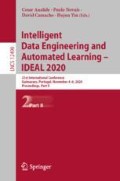Abstract
Cloud type classification is a complex multi-class problem where total sky images are analysed to determine their category such as Stratus or Cirrus, among others. However, many properties of this domain make high classification accuracy difficult to achieve. In this paper, we design a novel fusion approach, showing that recent image classification architectures based on deep learning, such as Convolutional Neural Networks, can be improved using statistical features directly calculated from images. In this research, three powerful CNNs have been trained on a comprehensive dataset: VGG-19, Inception-ResNet V2 and Inception V3. Simultaneously, a pool of standard machine learning classifiers have been trained on 14 different statistical characteristics on each colour channel. The results evidence that a fusion approach of the predictions of an image-trained CNN and a feature-trained Random Forest classifier improves the classification ability of both methods individually, reaching 95.05% macro average weighted precision over 12 classes in a complex highly imbalanced dataset with noisy examples.
Access this chapter
Tax calculation will be finalised at checkout
Purchases are for personal use only
References
Boers, R., et al.: Optimized fractional cloudiness determination from five ground-based remote sensing techniques. J. Geophys. Res. Atmos. 115(24) (2010). www.scopus.com
Breiman, L.: Random Forests. Mach. Learn. 45(1), 5–32 (2001). https://link.springer.com/article/10.1023/A:1010933404324
Caruana, R., Karampatziakis, N., Yessenalina, A.: An empirical evaluation of supervised learning in high dimensions. In: Proceedings of the 25th International Conference on Machine Learning, pp. 96–103 (2008). www.scopus.com
Cheng, H., Lin, C.: Cloud detection in all-sky images via multi-scale neighborhood features and multiple supervised learning techniques. Atmos. Meas. Tech. 10(1), 199–208 (2017). www.scopus.com
Chollet, F., et al.: Keras (2015). https://keras.io
Haiden, T., Forbes, R., Ahlgrimm, M., Bozzo, A.: The skill of ECMWF cloudiness forecasts. ECMWF Newsl. 143, 14–19 (2015). www.scopus.com
Haralick, R.M., Dinstein, I., Shanmugam, K.: Textural Features for Image Classification. IEEE Trans. Syst. Man Cybern. SMC 3(6), 610–621 (1973). www.scopus.com
Heinle, A., Macke, A., Srivastav, A.: Automatic cloud classification of whole sky images. Atmos. Meas. Tech. 3(3), 557–567 (2010). www.scopus.com
Hoyt, D.V.: Interannual cloud-cover variations in the contiguous united states. J. Appl. Meteorol. 17(3), 354–357 (1978)
Huertas Tato, J., et al.: Automatic cloud-type classification based on the combined use of a sky camera and a ceilometer. J. Geogr. Res. Atmos. (2017). https://e-archivo.uc3m.es/handle/10016/28557
Kazantzidis, A., Tzoumanikas, P., Bais, A.F., Fotopoulos, S., Economou, G.: Cloud detection and classification with the use of whole-sky ground-based images. Atmos. Res. 113, 80–88 (2012). www.scopus.com
Kliangsuwan, T., Heednacram, A.: Feature extraction techniques for ground-based cloud type classification. Expert Syst. Appl. 42(21), 8294–8303 (2015). www.scopus.com
LeCun, Y., Bengio, Y., Hinton, G.: Deep learning. Nature 521(7553), 436 (2015)
Lee, J., Weger, R.C., Sengupta, S.K., Welch, R.M.: A Neural Network Approach to Cloud Classification. IEEE Trans. Geosci. Remote Sens. 28(5), 846–855 (1990). www.scopus.com
Li, Y., Thompson, D.W.J., Stephens, G.L., Bony, S.: A global survey of the instantaneous linkages between cloud vertical structure and large-scale climate. J. Geophys. Res. 119(7), 3770–3792 (2014). www.scopus.com
Martín, A., Lara-Cabrera, R., Fuentes-Hurtado, F., Naranjo, V., Camacho, D.: EvoDeep: a new evolutionary approach for automatic deep neural networks parametrisation. J. Parallel Distrib. Comput. 117, 180–191 (2018)
Martín, A., Vargas, V.M., Gutiérrez, P.A., Camacho, D., Hervás-Martínez, C.: Optimising convolutional neural networks using a hybrid statistically-driven coral reef optimisation algorithm. Appl. Soft Comput. 90, 106144 (2020)
Simonyan, K., Zisserman, A.: Very deep convolutional networks for large-scale image recognition. arXiv preprint arXiv:1409.1556 (2014)
Singh, M., Glennen, M.: Automated ground-based cloud recognition. Pattern Anal. Appl. 8(3), 258–271 (2005). www.scopus.com
Szegedy, C., Ioffe, S., Vanhoucke, V., Alemi, A.A.: Inception-v4, inception-resnet and the impact of residual connections on learning. In: Thirty-First AAAI Conference on Artificial Intelligence (2017)
Szegedy, C., Vanhoucke, V., Ioffe, S., Shlens, J., Wojna, Z.: Rethinking the inception architecture for computer vision. In: Proceedings of the IEEE Conference on Computer Vision and Pattern Recognition, pp. 2818–2826 (2016)
Tzoumanikas, P., Nikitidou, E., Bais, A.F., Kazantzidis, A.: The effect of clouds on surface solar irradiance, based on data from an all-sky imaging system. Renew. Energy 95, 314–322 (2016). www.scopus.com
World Meteorological Organization : World Meteorological Organization/World Weather Research Programme (WMO/WWRP). Recommended methods for evaluating cloud and related parameters World Weather Research Programme (WWRP)/Working Group on Numerical Experimentation (WGNE) Joint Working Group on Forecast Verification Research (JWGFVR) (2012). www.scopus.com
Ye, L., Cao, Z., Xiao, Y.: DeepCloud: ground-based cloud image categorization using deep convolutional features. IEEE Trans. Geosci. Remote Sens. 55(10), 5729–5740 (2017)
Zhang, J., Liu, P., Zhang, F., Song, Q.: CloudNet: ground-based cloud classification with deep convolutional neural network. Geophys. Res. Lett. 45(16), 8665–8672 (2018)
Acknowledgment
This work has been supported by Spanish Ministry of Science and Education under TIN2014-56494-C4-4-P grant (DeepBio), and Comunidad Autónoma de Madrid under S2018/TCS-4566 grant (CYNAMON). We gratefully acknowledge the support of NVIDIA Corporation with the donation of the Titan V GPU used for this research.
Author information
Authors and Affiliations
Corresponding author
Editor information
Editors and Affiliations
Rights and permissions
Copyright information
© 2020 Springer Nature Switzerland AG
About this paper
Cite this paper
Huertas-Tato, J., Martín, A., Camacho, D. (2020). Cloud Type Identification Using Data Fusion and Ensemble Learning. In: Analide, C., Novais, P., Camacho, D., Yin, H. (eds) Intelligent Data Engineering and Automated Learning – IDEAL 2020. IDEAL 2020. Lecture Notes in Computer Science(), vol 12490. Springer, Cham. https://doi.org/10.1007/978-3-030-62365-4_13
Download citation
DOI: https://doi.org/10.1007/978-3-030-62365-4_13
Published:
Publisher Name: Springer, Cham
Print ISBN: 978-3-030-62364-7
Online ISBN: 978-3-030-62365-4
eBook Packages: Computer ScienceComputer Science (R0)

